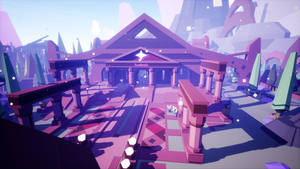Playing with optical illusions in Anamorphosis
Lucien Chen's interesting indie puzzler is all about finding the right vantage point so that hidden images become clear.

When I saw Anamorphosis at the Tokyo Game SHow's Sense of Wonder Night earlier this year, I was instantly reminded of Museum of Simulation Technology.
They're both first-person perspective puzzle games with mechanics based on optical illusions, so they do have a lot in common. Anamorphosis is based on the type of optical illusion that shares its name, wherein disjointed pieces look like a cohesive whole when seen from exactly the right angle. The goal in each level is to find that angle and, if necessary, make the exit gate materialize by flattening and volumizing objects in the world.
"The distorted image can be anywhere," says developer Lucien Chen, "such as on the ground, wall, or multiple surfaces. The player has a camera that can shift distorted images between illusion and reality. In order to solve the puzzle, the player needs to explore the environment and find the right vantage point, then use the camera to change the environment. This allows them to access new areas to complete the puzzles."
Lucien Chen, who has been making games since his college days, makes up one-third of the development team behind Anamorphosis. He's from Taiwan, though he got his master's degree from Carnegie Mellon University in the United States. One of his student projects earned a national award in Taiwan; another of his projects was showcased at Games for Change. He's worked at Sony on PlayStation VR and currently works at a mobile game company.

The game was inspired by an art exhibition Chen went to in Taiwan. "There was a 3D painting in one session which caught my eye immediately. I was thinking it would be cool if that image could be in real life, even becoming a game! I kept [thinking about] this idea until I had the opportunity to work on this prototype in 2013 with support from some programmer friends at CMU."
Anamorphosis is being produced in Unity 5 and uses object snapshots and hiding to effect its unique mechanics. "When you attempt to flatten an object, the game isolates the object you're pointing at and takes a picture of it using the player's view," says Chen. "It compares whether or not the object is projecting onto an acceptable surface, and then creates a projector at the point that the player is standing. After that, the object is hidden and the player is left with a view of what was once there, flattened onto the surface(s) behind it."
Implementing the mechanic was more difficult than Chen expected, however. "We encountered many technical problems when we were developing this feature, such as bugs and memory issues, and it sometimes forced us to change the way we design levels or execute optimization."

Since the game is a series of puzzles which each have a single solution, Chen considers level design to be of utmost importance in developing Anamorphosis. "First, I have to know what I want to deliver to players in the level," he says. "That also means that I need to understand the mechanic and the twist of the puzzle. Then I establish the environment around it." He begins on paper before trying to build the levels in Unity, but sometimes he finds that although an idea feels like it should work, it doesn't. Those aborted levels get set aside in case they can be useful later.
Finding like-minded people to work with on Anamorphosis has been another big challenge for Chen to face. "People tend to have different preferences and opinions," he says. "For an indie game developer, it takes more effort... to find the right working partners. Making games these days is not hard, but this game is not easy to complete because it contains lots of complex programming techniques, design, and art."
They did pick up a dedicated artist for Anamorphosis after Tokyo Game Show, which will allow them to improve upon the mechanical demo they showed at SOWN (see above video) and which is available for Windows now. Chen isn't sure how much longer development will take, but he's looking forward to reskinning the game with new art and introducing a story with a main character to inhabit the environments they are creating.
For Chen, the best part of developing Anamorphosis has been seeing people's reactions to the concept. "I never thought I could present this game at TGS's SOWN. When I showed the flattening feature on the stage and people were shaking the little hammers in response, I was touched." He also didn't expect the many positive reactions he got from players at his booth. "This is the motivation for us to keep working on it," says Chen. "This is my favorite thing about developing games."
About the Author(s)
You May Also Like













